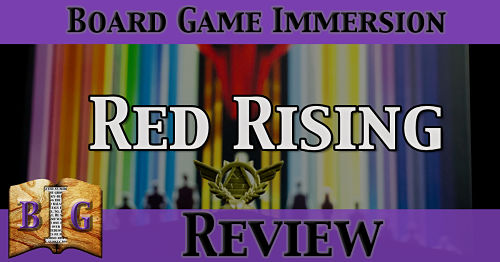At a Glance: Red Rising
Designers: Alexander Schmidt (II), Jamey Stegmaier
Publisher: Stonemaier Games
Artist: Jacqui Davis, Miles Bensky, Justin Wong
Editor: Not credited
Player Count: 1-5
Suggested Age: 14+
Playing Time: 45-60 minutes
Theme: Science Fiction, Red Rising
Mechanics: Card Drafting, Hand Management, Solitaire
Note: I was provided a complimentary copy of Red Rising for the purpose of review. The thoughts and opinions in this review are my own.
Intro Story
Since this game is based off a published novel (series, even), I won’t be writing anything for this one, as it’s already been written as glorious novels. The first in the series is called Red Rising by Pierce Brown, and it’s a fun read.
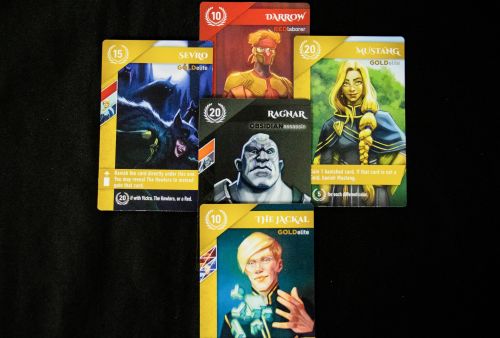
Overview/Roadmap
This review has two parts. First, there is the Short Review, where various aspects of the game are discussed. Then comes the Gameplay Review, in which the setup and gameplay are discussed in detail, along with initial thoughts. Following the Gameplay Review section are some final thoughts and a final verdict of the game. Feel free to jump around, or read it all in one go.
Short Review
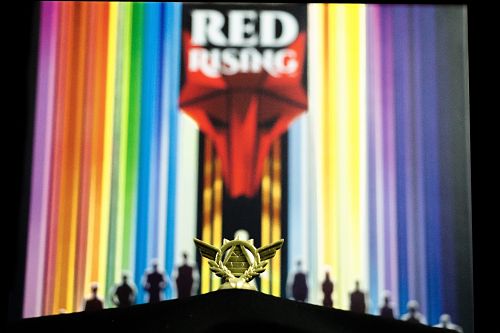
Red Rising (the board game, not the book) borrows its main mechanic from the game Fantasy Realms (which is a wonderful game, by the way), and adds more complexity (in a good way) to provide some fun choices.
Immersion
Despite being themed after the book series of the same name, the Red Rising board game isn’t as “immersive” as one might expect. That’s not to say that it isn’t, but the gameplay isn’t so much story-based as it is great mechanics with a great theme. Still, I find it immersive enough, in that I’m highly engaged while playing. And isn’t that what we all want in a game?
Red Rising Theme
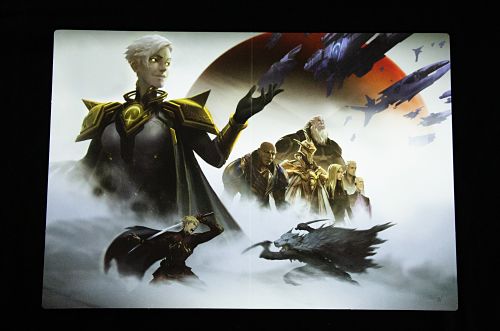
The Red Rising theme is strong in the cards and locations; however, the gameplay itself isn’t so much focused on theme as it is on mechanics. And one can argue that it’s the mechanics that make a game (#truth). However, the theme really does come across in how the cards react to each other. Certain characters pair well with certain other characters, and if you’ve read the books, the pairings (or negative pairings) make perfect sense. Honestly, despite not being a game mechanically driven by its theme, the Red Rising theme still comes across nicely where fans of the series will enjoy it, but those who haven’t read the books won’t be at a disadvantage.
Components
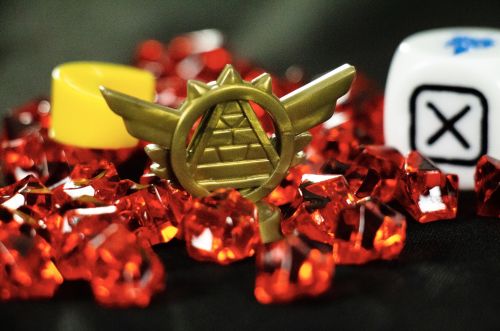
This is a Stonemaier Games product, so you can expect good quality components. The collector’s edition is essentially the deluxe version, complete with metal tokens and card holders. The regular retail version has plastic cubes and tokens rather than metal, and does not include the card holders. Having played both versions of the game, I can honestly say that the retail version is just as good as the deluxe collector’s edition (unless you absolutely need those metal pieces). The plastic tokens and cubes in the retail game are still good quality, and the card holders were more a nuisance than anything in our play of a friend’s deluxe version. In fact, we hardly used the card holders while we played. Those that did found out quickly that the holders with cards in them tip over easily, thus revealing your hand to everyone else.
Standout Performances
- Strong theme
- Strong mechanics
- Information isn’t exclusive to those who read the book series
- Retail version is just as great as the collector’s edition
- Simple rules with lots of depth to gameplay
- A huge amount of replay value
- Solo variant is intuitive, fast, and feels much like how a regular game would play out
Breaking the 4th Wall
In theater, breaking the fourth wall refers to when characters (or something else) directly address the audience, thus pulling them out of the narrative and making the astutely aware that they are, in fact, watching a performance and that’s it’s not actually real.
While this reviewing isn’t exactly about the deluxe version, I have played with it so I do know first-hand what it involves. That said, I didn’t find the card holders particularly useful. I’m sure some will appreciate them, as it does make it easier to see all of your cards at once, but the risk of toppling them for all to see isn’t always worth the convenience.
I’m sure the majority of you won’t call this a negative, but there are approximately two cards that show a bit too much skin for my liking. True, it plays to the theme, but it’s not something I want to see, and especially something I don’t want my young boys to see. That said, there’s far worse in other games (which I don’t play, mind you), so this is more of a personal nitpick than anything.
Gameplay Review
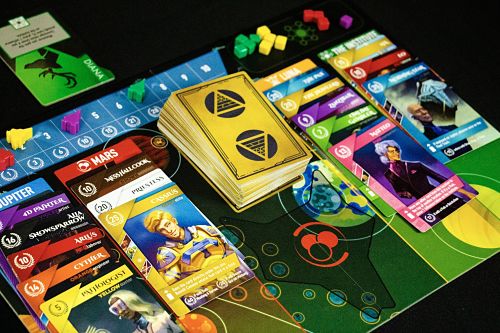
First Impressions
First impressions count, and Red Rising dressed up nicely for the interview. I enjoy the art on the cards (even though they’re not how I envisioned things), and the simple nature of setup made it easy to jump into. Likewise, the component quality was nice (this is for the retail version, remember) and the rule book was easy to follow.
Setup
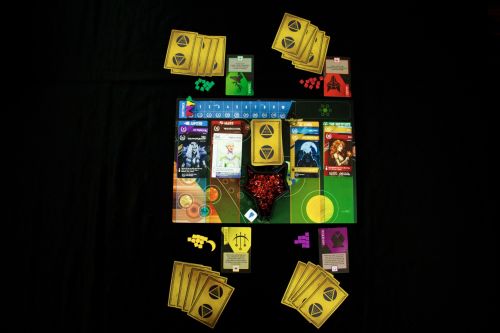
As mentioned, setting up the game is simple enough. Set out the board, give each player their own unique house (i.e. faction with special power) shuffle all of the character cards, and put the helium tokens in the fox head container on the board. Deal two cards to each location, and each player is dealt 5 cards to form their starting hand. Take the cubes and ship token in your color (placing the ship token at the “0” of the Fleet Track), and you’re ready to play!
Seriously, there really isn’t a lot to setup, which makes it a great deal more accessible.
Red Rising Gameplay
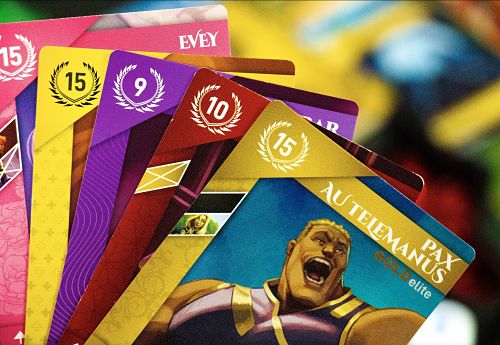
The gameplay is, of course, the factor that is most people care about above all else. And, before I get too involved, let me just say that it is a lot of fun.
The main thing you will do on your turn is discard one of the cards from your hand to one of the locations on the board (making sure to keep visible the other cards underneath it). Then you take a card from a location other than the one you discarded to. When you take a card, you perform that location’s action.
- Jupiter: Advance +1 on the Fleet Track
- Mars: Gain a helium token
- Luna: Gain the first player token and activate your house’s ability
- The Institute: Place one of your cubes at the Institute
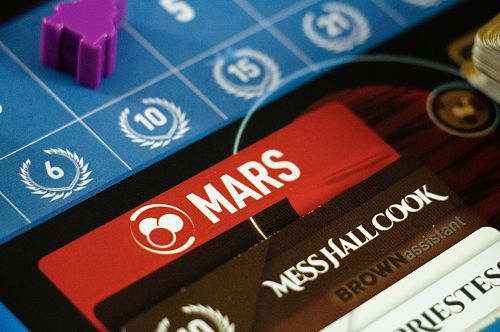
That sounds pretty simple, right? Well, it is! But when you discard a card (i.e. “deploy”), you take that card’s Deploy action. There are so many different things they can do, so I won’t get into all of them, but they provide benefits, such as gaining helium, getting an additional card, banishing a card to be out of play, placing a cube at the Institute, and a ton more.
Likewise, the cards you have in your hand at the end of the game are how you will score most of your points. Most cards have other specific cards that they give you extra points for having in your hand alongside them, as well as subtract points for certain cards. So you’re constantly deploying and picking up new cards, trying to make your hand the most compatible with each other card, not to mention using the Deploy abilities and picking up from certain locations to activate abilities. There’s a lot to think about, and while the mechanics are simple enough, the variety of cards and abilities make it a never ending game of musical chairs cards.
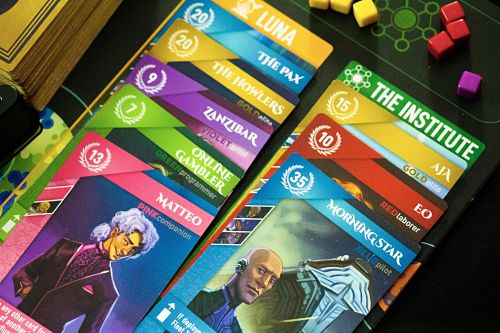
If you don’t want to take a card from any of the locations, you can simply take the top card from the top of the deck. Because this isn’t exactly a location, you are given the chance to roll the reward die. Whatever the result comes up as is what you get. The rewards are everything from the four locations, plus the additional “bonuses” of banishing a card or drawing a new card from the top of the deck and placing it on a location (without any perks or bonuses). Those two additional “bonuses” aren’t my favorite, but they could be useful, depending on what’s out there or what you draw.
Another option you have, instead of discarding a card then taking a card, you can simply draw one from the top of the deck, place it at a location, and take that location’s action. That’s it, turn’s over. It’s a great option if you’re happy with how your hand currently is, plus you still get a location bonus, which is always nice.
The end of the game is triggered once one player has reached two of the following:
- Has 7 helium
- Has passed the “7” space on the Fleet Track
- Has 7 cubes at the Institute
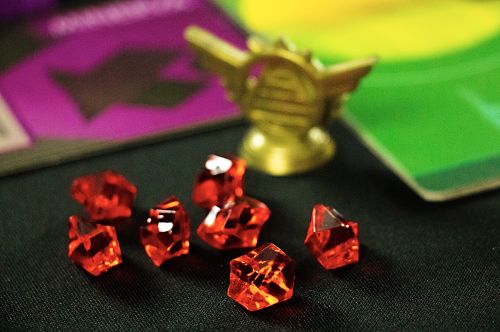
The game also ends if all three of those conditions are met by any combination of players. So pay attention to where everyone is in regards to those conditions; otherwise, the game could end with you being stuck with some unwanted cards.
You get points for cubes at the Institute (if you have the most, you get more points per cube than the others, etc.), for each helium (3 points a piece), points based on your position on the Fleet Track, and 10 points if you have the Sovereignty token. Likewise, each card in your hand is worth a certain amount of points (top-left corner), and can potentially score you bonus points (or make you lose points) depending on what other cards you have in your hand.
The scores can get pretty high sometimes, but the game includes a pad of score sheets to make counting points a little easier.
Thoughts on Gameplay
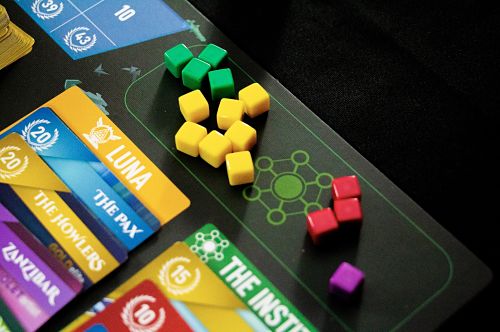
This game is pretty gorydang good. I love how there are so many combinations of cards that work together so wonderfully. It’s difficult to get the cards you want, and sometimes you have to abandon your plan (or plans) and start going for something else.
Turns can really zip by, if all goes according to plan. Of course, that doesn’t happen as often as we’d like. Still, after a game or two, you should be comfortable enough with the cards and what they do that turns should go quickly and smoothly, regardless of how many times your plans were foiled between turns.
Solo Play

The solo variant of Red Rising is good. It simulates a second player nicely, and is pretty quick to play through as well. The solo AI, dubbed Tull au Toma, works off a solo deck of cards that dictate which actions Tull au Toma will take that turn. It is quite straight forward, and takes only a couple of turns to catch on to. I really enjoy playing Red Rising solo, as it’s a fast play that still feels like a legit game with another player. Of course, the rules are tweaked slightly for the Au Toma, but I’m quite pleased with how it plays out.
Final Thoughts
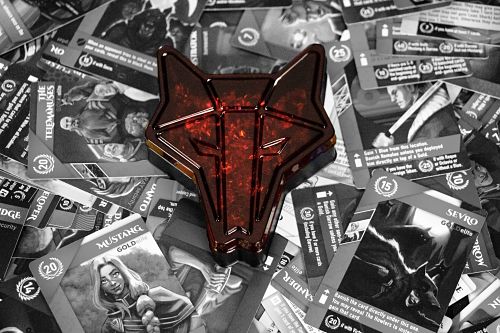
Having played Red Rising with player counts from 1 to 5, I can attest that the game plays well at all player counts. The two-player and solo game play a lot faster than the 5-player game. While all of the Stonemaier Games games I’ve played have been wonderful (Red Rising included), this isn’t my favorite game from them, but it is one I’ll be playing quite a bit—especially solo, due to its quick setup and fast gameplay.
Admittedly, my wife wasn’t a big fan of this one. I thought she would enjoy the card interplay, but she just wasn’t feeling it, and she gave it multiple chances as well. So while I my final verdict below is based on my personal thoughts and opinions, you may want to keep in mind that those thoughts aren’t unanimous, at least in this household. My game group, on the other hand, seemed to like it just fine. So there’s that.
For fans of the novels, Red Rising (the board game) does the theme well in the art and cards, but if you’re looking for an adventure/story/etc that you play through, this is not it. What it is, however, is a game that twists your brain as you try and find compatible cards. It’s a game that pairs cards thematically. And, perhaps most importantly, it is a game that is a lot of fun to play. And that’s the gorydang truth.
Red Rising: Final Verdict
Welp, here it is, the final judgement of the Red Rising board game. Personally, I enjoy it quite a bit. It’s a good game to get your brain moving, and if you’re a fan of the series, the art and theme is an excellent bonus. Coupled with a solid solo variant and fun gameplay at all player counts, I am giving Red Rising a rating of Two Captivating Thumbs. It’s more than very good (in my humble opinion), but it falls short of outstanding. Still, Red Rising is a rewarding game to play, and I think I’ll always enjoy playing it.
Verdict Scale (Lowest to Highest)
The Final Verdict is based on a scale of 1-7, although this scale is not numbered. Instead, it uses thematically appropriate words to describe the performance of the game.
Tomatoes – This game was emotionally taxing and difficult to finish.
Uninspiring – This game had me daydreaming about other games.
Lackluster – This game had its moments, but it probably won’t see much table time.
Laodicean – This game is decent. It works. There’s a reason people like it.
Two Thumbs Up – This game is very good.
Captivating – This game is outstanding! It’s more than good; it’s practically a staple.
Standing Ovation – This is the best game you will ever play. Period.
Read short fiction inspired by board games at BGI’s stories page!

